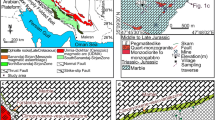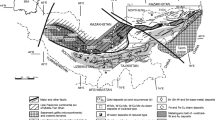Abstract
An Upper Miocene (9.12 ± 0.19 Ma; biotite 40Ar/39Ar) shallow pluton and numerous dykes and sills of felsic–intermediate compositions intruded the Upper Cretaceous, flysch-type sediments in the Mivehrood area, northwest Iran. The intrusions caused extensive thermal metamorphism and metasomatism, leading to the formation of hornfels and skarn. A massive skarn, 1–10 m thick, immediate to the intrusive contact, is bordered by a banded skarn, 100–400 m thick, that grades outward into hornfels and original sediments. The Mivehrood pluton is characterized by steep REE pattern, high Al2O3 (14.64–16.4 wt%) and Sr (380–786 ppm), and low MgO (1.3–3.4 wt%), Y (4.8–10.7 ppm), and Yb (0.35–0.95 ppm), characteristics typical of high-silica adakites. Skarn formation started with thermal metamorphism, followed by anhydrous prograde and hydrous retrograde stages. Prograde and retrograde mineral assemblages are developed in both skarns, represented by garnet–clinopyroxene–wollastonite and epidote–actinolite–scapolite–chlorite, respectively. Granditic F-bearing garnet dominates clinopyroxene in both skarns. The banded skarn contains minor scapolite of marialite composition. The calc-silicate mineral assemblages and the mineral chemistry allow the Mivehrood skarn to be classified as a calcic, oxidized skarn. Mass balance assessments suggest that Fe, Si, and S were significantly enriched, and Na, LILEs, and LREEs were strongly depleted, in the massive skarn. In the banded skarn, Na, K, Si, and S were enriched. Significant dehydration and carbon degassing occurred in both skarns. Stockworks, veins, and replacement bodies of pyrite ± chalcopyrite locally occur in the pluton and the dykes and in the skarns. The δ34SCDT values for the sulfides fall in a narrow range around 0.0 ‰, suggesting a magmatic source for sulfur and possibly the hydrothermal water and solutes involved in the skarn formation.














Similar content being viewed by others
References
Alirezaei S, Hassanpour S (2011) An overview of porphyry copper deposits in Iran. The 1st world copper congress, Iran; Proceedings with abstracts, pp 49–62
Alirezaei S, Mohammadzadeh Z (2009) Hydrothermal alteration-mineralization at Chahfiroozeh porphyry copper deposit, Kerman province, southern Iran. AGU 2009 Joint Assembly, Toronto, GA71A-15 (abstract)
Alirezaei S, Einali M, Arjmandzadeh R (2006) Porphyry-skarn relations; example from Mivehrood area, northwest Iran. GAC-MAC annual meeting; Montreal, Canada, Proceeding with abstracts, 31, 3
Arjmandzadeh R (2006) The geochemistry, alteration and gold mineralization in the Kharvana (Mivehrood) granitoid stock, East Azarbaijan. MSc thesis, Shahid Beheshti University, Tehran, Iran. In Persian with English abstract
Berberian F, Berberian M (1981) Tectono-plutonic episodes in Iran. In: Gupta HK, Delany FM (eds) Zagros-Hindu Kush-Himalaya geodynamic evolution, vol 3., Geodynamics SeriesAmerican Geophysical Union, Washington, pp 5–32
Berberian M, King GC (1981) Towards a paleogeography and tectonic evolution of Iran. Can J Earth Sci 18:210–265
Calagari A, Hosseinzadeh G (2006) The mineralogy of copper-bearing skarn to the east of the Sungun-Chay river, East-Azarbaijan, Iran. J Asian Earth Sci 28:423–438
Chakhmouradian AR, Cooper A, Medici L, Hawthorne F, Adar F (2008) Fluorine-rich Hibschite from silicocarbonatite, Afrikanda Complex, Russia: crystal chemistry and conditions of crystallization. Can Mineral 46:1033–1042
Changsheng L, Reed MH, Misra KC (1992) Zinc-lead skarn mineralization at Tin Creek, Alaska: fluid inclusions and skarn-forming reactions. Geochim Cosmochim Acta 56:109–119
Davies JH, Blanckenburg VF (1995) Slab breakoff: a model of lithosphere detachment and its test in the magmatism and deformation of collisional orogenes. Earth Planet Sci Lett 129:85–102
Deer WA, Howie RA, Zussman J (1991) An introduction to the rock-forming minerals, 2nd ed. Longman Scientific
Defant MJ, Drummond MS (1990) Derivation of some modern arc magmas by melting of young subducted lithosphere. Nature 347:662–665
Defant MJ, Kepezhinskas PK (2001) Evidence suggests slab melting in arc magmas. EOS 82:62–70
East Azarbaijan Bureau of Mines (2000) Exploration for precious metals in Kharvana (Mivehrood) area. Internal report, 125 p (In Persian)
Einali M (2006) The geochemistry, alteration, and gold mineralization in the metamorphic-metasomatic rocks in the Kharvana (Mivehrood) area, East Azarbaijan. MSc thesis, Shahid Beheshti University, Tehran, Iran. In Persian, with English Abstract
Einaudi MT (1982) General features and origin of skarns associated with porphyry copper plutons. In: Titley SR (ed) Advances in the geology of porphyry copper deposits: southwest north America. University of Arizona Press, pp 185–209
Einaudi MT, Meinert LD, Newberry RJ (1981) Skarn deposits. Econ Geol 75th Anniversary Volume, pp 317–391
Fontbote L, Vallance J, Markowski A (2004) Oxidized gold skarns in the Nambija district, Ecuador. Soc Econ Geol 11:341–357
Forster DB, Seccombe PK, Phillips D (2004) Controls on Skarn Mineralization and Alteration at the Cadia Deposits, New South Wales, Australia. Econ Geol 99:761–788
Franchini MB, Meinert LD, Montenegro TF (2000) Skarns related to porphyry-style mineralization at Caicayen Hill, Neuquen, Argentina: composition and evolution of hydrothermal fluids. Econ Geol 95:1197–1213
Gresens RL (1967) Composition–volume relationships of metasomatism. Chem Geol 2:47–55
Hassanpour S (2010) Metallogeny and mineralization of Cu-Au in Arasbaran Zone, NW of Iran. PhD thesis, Shahid Beheshti University, Tehran, Iran. In Persian, with English Abstract
Hassanpour S (2013) The alteration, mineralogy and geochronology (SHRIMP U-Pb and 40Ar/39Ar) of copper-bearing Anjerd skarn, north of the Shayvar mountain, NW Iran. Int J Earth Sci 102:687–699
Hassanpour S, Alirezaei S, Selby D, Sergeev S (2015) SHRIMP zircon U-Pb and biotite and hornblende Ar–Ar geochronology of Sungun, Haftcheshmeh, Kighal, and Niaz porphyry Cu–Mo systems: evidence for an early Miocene porphyry-style mineralization in northwest Iran. Int J Earth Sci 104:45–59
Hassanzadeh J (1993) Metallogenic and tectonomagmatic events in the SE sector of the Cenozoic active continental margin of central Iran (Shahr-e-Babak area, Kerman province). PhD thesis, University of California
Heidari F (2009) Geology, alteration and mineralization in the Iju copper deposit, Kerman Province, Iran. MSc thesis, University of Tehran, Tehran, Iran. In Persian, with English Abstract
Hezarkhani A, Williams-Jones AE (1998) Controls of alteration and mineralization in the Sungun porphyry copper deposit, Iran: evidence from fluid inclusions and stable isotopes. Econ Geol 93:651–670
Knowles CR (1987) A basic program to recast garnet end members. Comput Geosci 13:655–658
Kretz R (1983) Symbols for rock-forming minerals. Am Mineral 68:277–279
Kuscu I, Gencalioglu G, Meinert LD, Floyed PA (2002) Tectonic setting and petrogenesis of the Celebi granitoid (Kirikkale-Turkey) and comparison with world skarn granitoids. J Geochem Explor 76:175–194
Kwak TAP (1986) Fluid inclusions in skarns (carbonate replacement deposits). J Metamorph Geol 4:363–384
Kwak TAP (1994) Hydrothermal alteration in carbonate-replacement deposits; ore skarns and distal equivalents. In: Lentz DR (ed) Alteration and alteration processes associated with ore-forming systems. Geological Association of Canada, Short Course Notes, vol 11, pp 381–402
Logan MAV (2000) Mineralogy and geochemistry of the Gualian skarn deposit in the Precordillera of Western Argentina. Ore Geol Rev 17:113–138
Manning CE, Bird DK (1990) Fluorian calcic garnets from the host rocks of the Skaergaard intrusion: implications for metamorphic fluid composition. Am Mineral 75:859–873
Martin H (1999) Adakitic magmas: modern analogues of Archaean granitoids. Lithos 46:411–429
McInnes BIA, Evans NJ, Belousova E, Griffin WL (2003) Porphyry copper deposits of the Kerman belt, Iran: timing of mineralization and exhumation processes. CSIRO Science Resource Report 41
Mehrpartou M (1997) Geological Map of the Siahrood Quadrangle. No. 5267, 1:100000 Series, Geological Survey of Iran
Meinert LD (1982) Skarn, manto, and breccia pipe formation in sedimentary rocks of the Cananea mining district, Sonora, Mexico. Econ Geol 77:919–949
Meinert LD (1984) Mineralogy and petrology of iron skarns in western British Columbia, Canada. Econ Geol 79:869–882
Meinert LD (1992) Skarns and skarn deposits. Geosci Can 19:145–162
Meinert LD, Hedenquist JW, Satoh H, Matsuhisa Y (2003) Formation of anhydrous and hydrous skarns in Cu–Au ore deposits by magmatic fluids. Econ Geol 98:147–156
Middlemost EAK (1994) Naming materials in the magma/igneous rock system. Earth Sci Rev 37:215–224
Mollai H, Sharma R, Pe-Piper G (2009) Copper mineralization around the Ahar batholith, north of Ahar (NW Iran): evidence for fluid evolution and the origin of the skarn ore deposit. Ore Geol Rev 35:401–414
Myers GL (1994) Geology of the Copper Canyon-Fortitude skarn system, Battle Mountain, Nevada. PhD thesis, Washington State University, USA
Ohmoto H, Goldhaber MB (1997) Isotopes of sulfur and carbon. In: Barnes HL (ed) Geochemistry of hydrothermal ore deposits. 3rd ed. Wiley, pp 517–611
Pan Y, Fleet ME, Ray GE (1994) Scapolite in two Canadian gold deposits: Nickel Plate, British Columbia, and Hemlo, Ontario. Can Mineral 32:825–837
Pearce JA (1983) Role of the sub-continental lithosphere in magma genesis at active continental margins. In: Hawkesworth CJ, Norry MJ (eds) Continental basalts and mantle xenoliths. Shiva Press, Nantwich, pp 230–249
Pearce JA, Harris NBW, Tindle AG (1984) Trace element discrimination diagrams for the tectonic interpretation of granitic rocks. J Petrol 25:956–983
Ray GE, Webster ICL (1991) An overview of skarn deposits. In: Ore deposits, tectonics and Metallogeny in the Canadian Cordillera. British Columbia Ministry of Energy, Mine and Petroleum Resources, Paper 4:213–252
Richards JP (2009) Postsubduction porphyry Cu–Au and epithermal Au deposits: products of remelting of subduction-modified lithosphere. Geology 37:247–250
Richards JP, Kerrich R (2007) Adakite-like rocks: their diverse origins and questionable role in metallogenesis. Econ Geol 102:537–576
Samani B (1998) Distribution, setting and metallogenesis of copper deposits in Iran. In: Porter TM (ed) Porphyry and hydrothermal copper and gold deposits: a global perspective, Perth, 1998, conference proceedings: Glenside, South Australia, Aust Min Found pp 135–158
Shafiei B, Haschke M, Shahabpour J (2009) Recycling of orogenic arc crust triggers porphyry Cu-mineralization in Kerman Cenozoic arc rocks, southeastern Iran. Miner Deposita 44:265–283
Smith MP, Henderson P, Jeffries TER, Long J, Williams CT (2004) The Rare Earth Elements and Uranium in Garnets from the Beinn and Dubhaich Aureole, Skye, Scotland, UK: constraints on processes in a dynamic hydrothermal system. J Petrol 45:457–484
Stampfli GM (2000) Tethyan ocean. In: Bozkhurt E, Whichester JA, Piper JDA (eds) Tectonic and magmatism in Turkey and surrounding area. Special Publication, pp 1–23
Stöcklin J, Setudenia A (1972) Lexique stratigraphique international, vol III. ASIE Centre National De La Recherche Scientifique, Paris 75
Sun SS, McDonough WF (1989) Chemical and isotopic systematics of oceanic basalts: implications for mantle composition and processes. In: Sunders AD, Norry MJ (eds) Magmatism in the Ocean Basins. Geological Society Special Publications, London, pp 313–345
Taghipour N, Aftabi A, Mathur R (2007) Geology and Re-Os geochronology of mineralization of the Miduk porphyry copper deposit, Iran. Resour Geol 58:143–160
Ulrych J, Povondra P, Pivec E, Rutšek J, Sitek J (1994) Compositional evolution of metasomatic garnet in melilitic rocks of the Osečná complex, Bohemia. Can Mineral 32:637–647
Valley JW, Essene EJ, Peacor DR (1983) Fluorine- bearing garnets in Adirondack calc- silicates. Am Mineral 68:444–448
Verdel C, Wernicke BP, Hassanzadeh J, Guest B (2011) A Paleogene extensional arc flare-up in Iran. Tectonics 30(TC3008):19
Zahedi A, Boomeri M, Nakashima K, Mackizadeh MA, Ban M, Lentz DR (2014) Geochemical characteristics, origin, and evolution of ore-forming fluids of the Khut Copper Skarn deposit, west of Yazd in Central Iran. Resour Geol 64:209–232
Acknowledgments
The research was financially supported by East Azarbaijan Bureau of Mines (EABM). We would like to express our sincere thanks to H. Farahmand, the director, and S. Gholami, the chief geologist at EABM. We greatly appreciate M. Zarghami, a former geologist at EABM, for proposing the subject and for his support throughout the studies.
Author information
Authors and Affiliations
Corresponding author
Electronic supplementary material
Below is the link to the electronic supplementary material.
Rights and permissions
About this article
Cite this article
Alirezaei, S., Einali, M., Jones, P. et al. Mineralogy, geochemistry, and evolution of the Mivehrood skarn and the associated pluton, northwest Iran. Int J Earth Sci (Geol Rundsch) 105, 849–868 (2016). https://doi.org/10.1007/s00531-015-1200-4
Received:
Accepted:
Published:
Issue Date:
DOI: https://doi.org/10.1007/s00531-015-1200-4




